This post may contain affiliate links. Please read our disclosure policy.
Introducing the ultimate vegan broccoli rice casserole! This simple casserole delivers plenty of cheese flavor, a super creamy consistency, and comes with an abundance of tender broccoli florets. A wonderful plant-based dish that will warm you up from the inside!
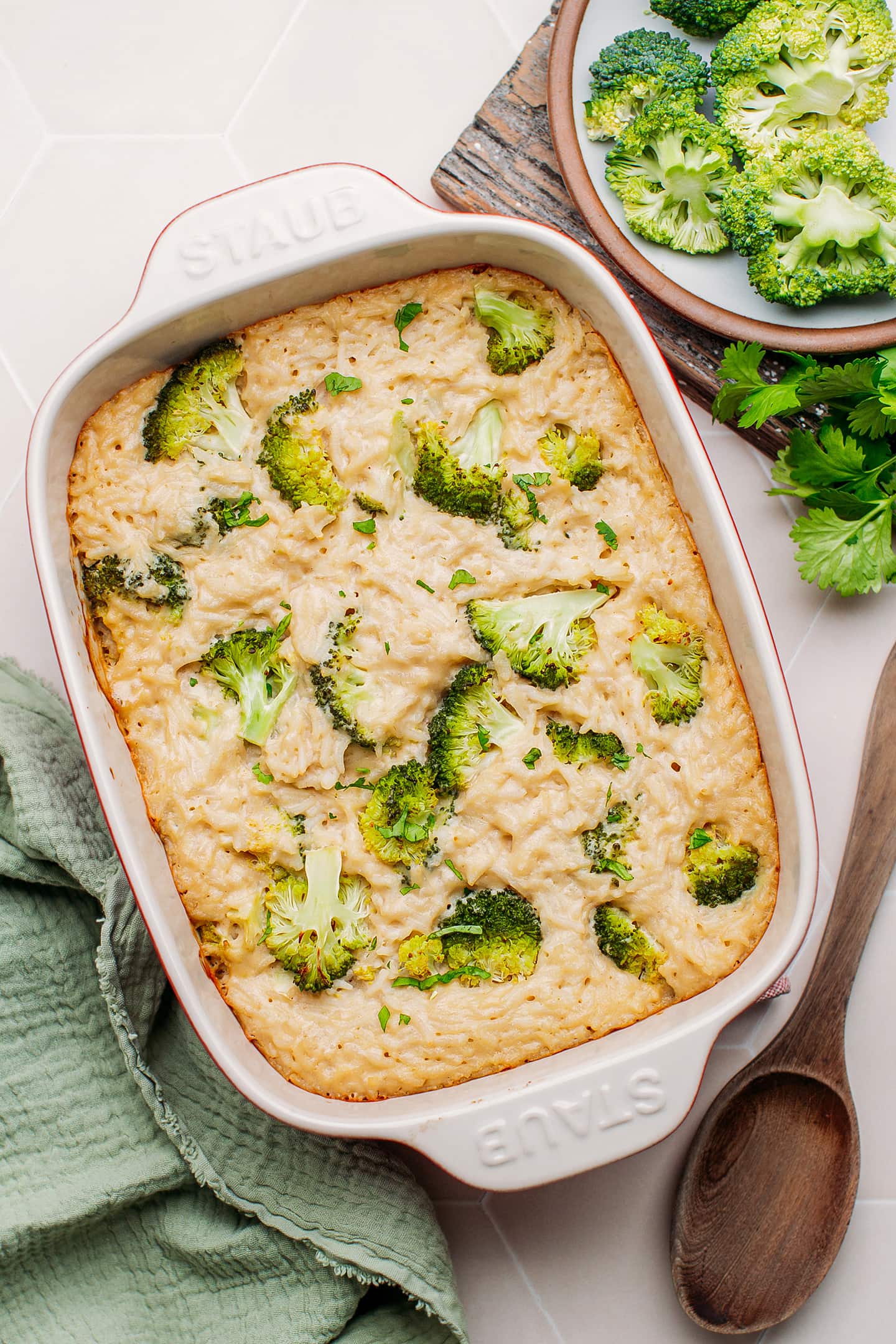
⭐️ Why You Should Try It
- Incredibly cheesy and creamy. The vegan cheese sauce, made from a base of cashews for creaminess, nutritional yeast and miso for cheesy goodness, and elevated with a splash of white wine, packs a ton of flavor. Plus, this broccoli rice casserole doesn’t require any store-bought vegan cheese (unless you want to add that as an extra topping).
- A great way to use leftover rice. If you have ever wondered what to do with leftover rice sitting in the fridge, you will love this casserole recipe!
- Warming and comforting. Casseroles are one of the most comforting dishes to enjoy during Winter. They bring warmth, serve a crowd, and require little effort. This recipe is no exception! Each bite is filled with a sensation of coziness!
📘 What is Broccoli Rice Casserole
A broccoli rice casserole is a classic American side dish that consists of cooked rice and broccoli florets coated with a cheesy sauce and baked until golden brown. It is typically served as a side dish.
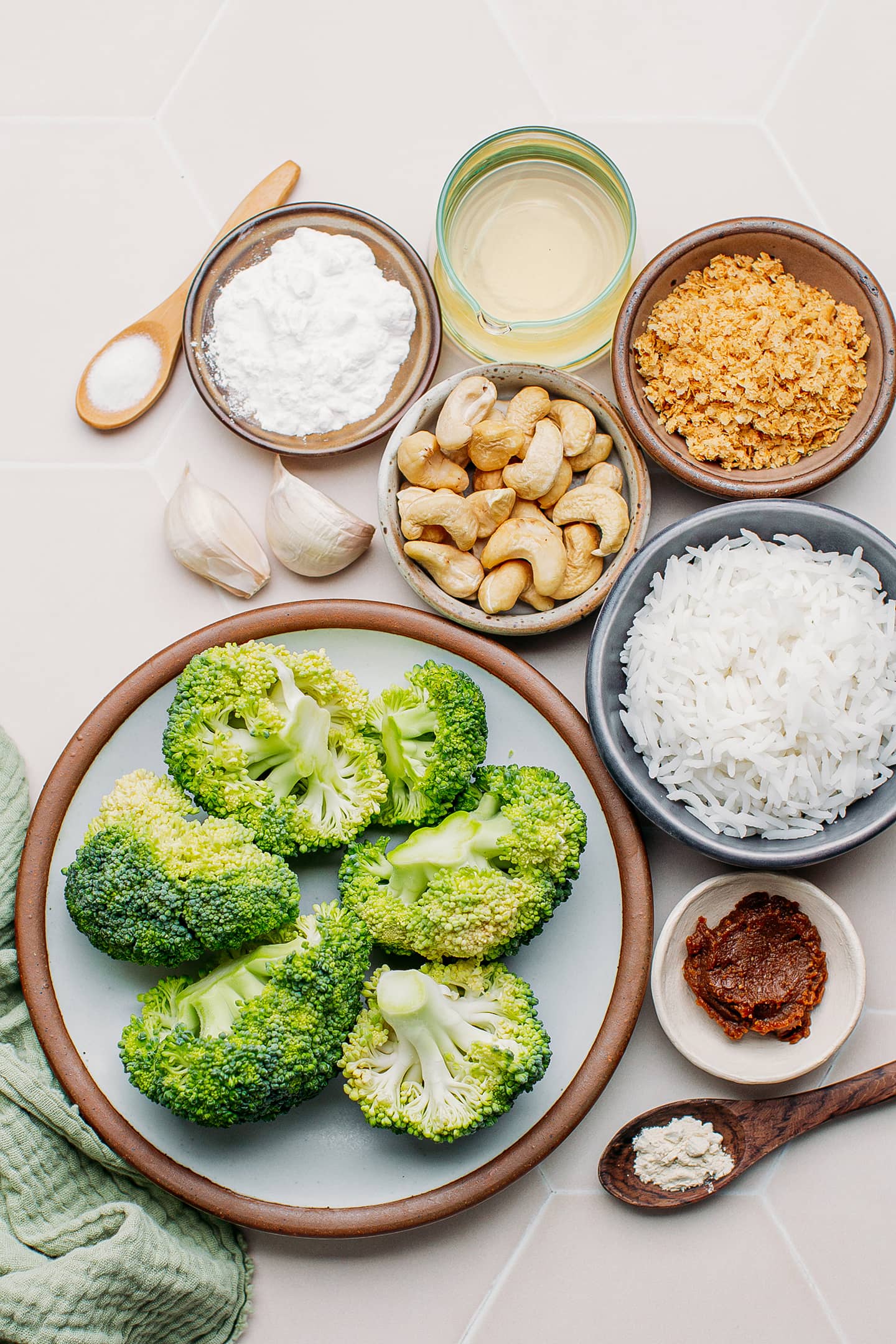
🥦 Ingredient Notes
Here are the ingredients that you will need to prepare this casserole:
- Cooked rice – Any type of cooked rice will work. I went with white rice, but brown rice will work too.
- Broccoli – Fresh broccoli is preferred, but frozen broccoli works as well. If using frozen broccoli, pat it dry after thawing to ensure it won’t release water during baking.
- Raw cashews – Soaked raw cashews make the base of the cheese sauce, creating a velvety smooth consistency.
- White wine – A key ingredient to add flavor and tanginess to the casserole. If you don’t want to use wine, replace it with water and add a tablespoon of white vinegar.
- Nutritional yeast – Nutritional yeast is responsible for the cheese flavor in the sauce.
- Oil – To add extra richness and creaminess to the cheese sauce. Use a neutral oil such as canola or grapeseed oil.
- Tapioca starch – To thicken the sauce. You can replace it with cornstarch or arrowroot.
- White miso – To enhance the cheesy flavor. White miso not only brings plenty of umami but also saltiness.
- Sugar – A hint of sugar balances the tanginess and saltiness of the sauce.
- Onion powder – For a pungent flavor. Do not replace it with fresh onions, as it would not taste the same.
- Garlic – I prefer using fresh garlic, but feel free to use 1/2 tsp of garlic powder.
- Salt – To enhance the overall flavor of the dish.
🥣 How to Make It
Make the cheese sauce
- Soak the cashews. Start by soaking the cashews overnight in cold water. You can speed up the process by pouring boiling water over the cashews and letting them sit for 25-30 minutes.
- Drain them. Next, rinse the cashews and drain them well.
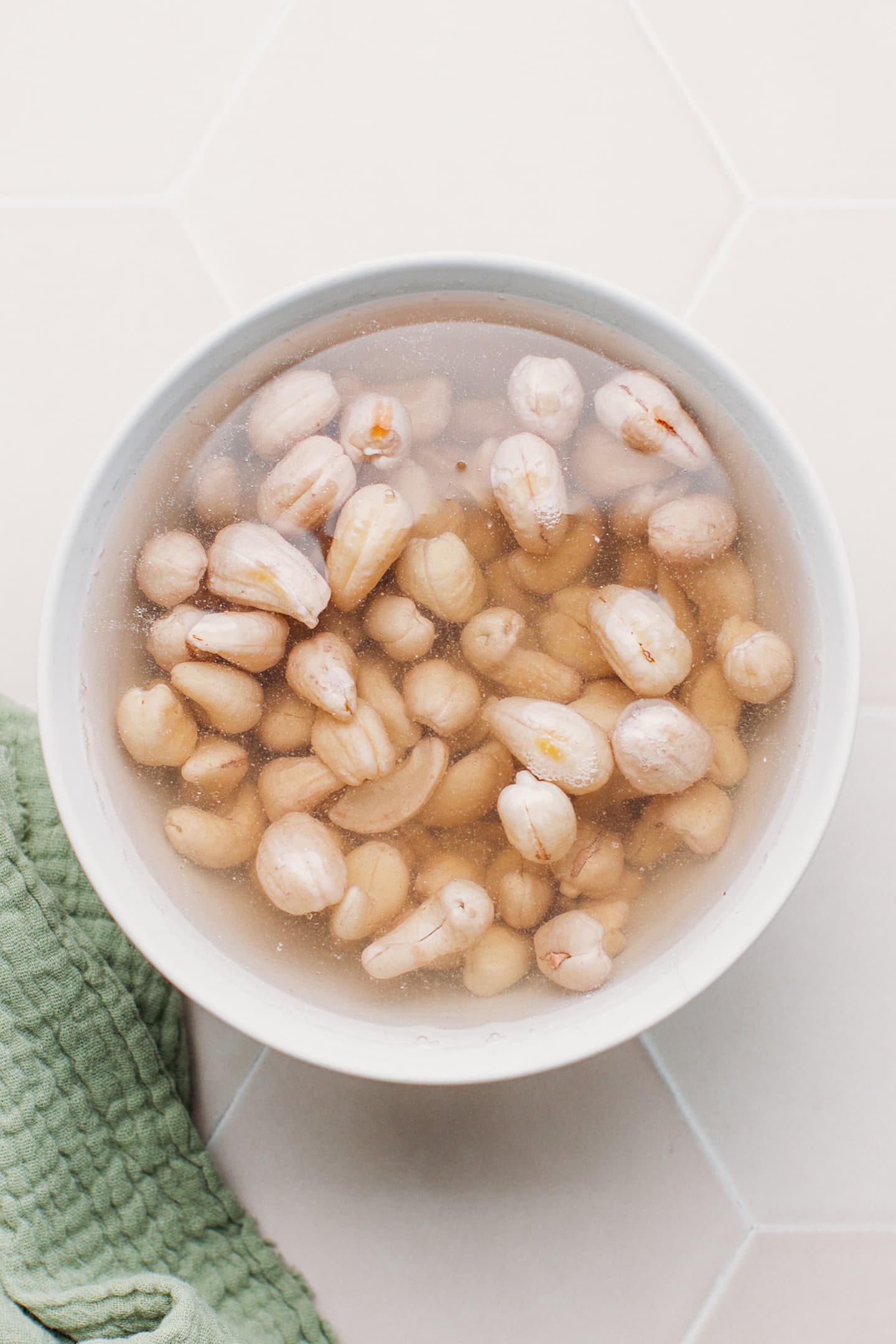
- Transfer the cashews to a blender. Transfer the soaked cashews to a high-speed blender. Note: you must use a blender for this recipe. A food processor would yield a very chunky texture.
- Add the remaining ingredients. To the blender, add the water, white wine, nutritional yeast, oil, white miso, sugar, onion powder, salt, and garlic.
- Blend until smooth. Blend on high speed for 40-60 seconds or until the sauce is completely smooth.
- Thicken the sauce. Transfer the sauce to a medium saucepan and add the tapioca starch. Heat it over medium heat, whisking constantly until the sauce thickens. This step will take approximately 5 minutes.
Prepare the filling
- Coat the rice with the sauce. Transfer the cooked rice and cheese sauce to a mixing bowl. Using a wooden spoon, stir to coat the rice with the sauce.
- Stir in the broccoli. Add the broccoli florets and stir to combine.
🧊 How to Blanch Broccoli
If you want the broccoli to keep its vibrant green color during baking, you can blanch it. Blanching is a process that consists of immersing a vegetable in boiling water for a few minutes and then transferring it to cold water. This process helps the color set. To do so:
- Bring a large pot of water to a boil.
- Once boiling, add the broccoli and boil it for 2 minutes.
- Drain the broccoli and transfer it to a bowl filled with ice-cold water. Alternatively, you can rinse it under cold water.
- Drain the broccoli well before using.
Bake
- Transfer to a baking dish. Transfer the rice and broccoli with the sauce to an oven-safe baking dish.
- Cover with foil. This will prevent the top from browning too quickly and help the casserole to stay creamy.
- Bake until golden brown. Finally, bake the casserole for 35 minutes in a 350°F (175°C) preheated oven. Remove the foil and bake for another 8-10 minutes or until the top is slightly golden brown.
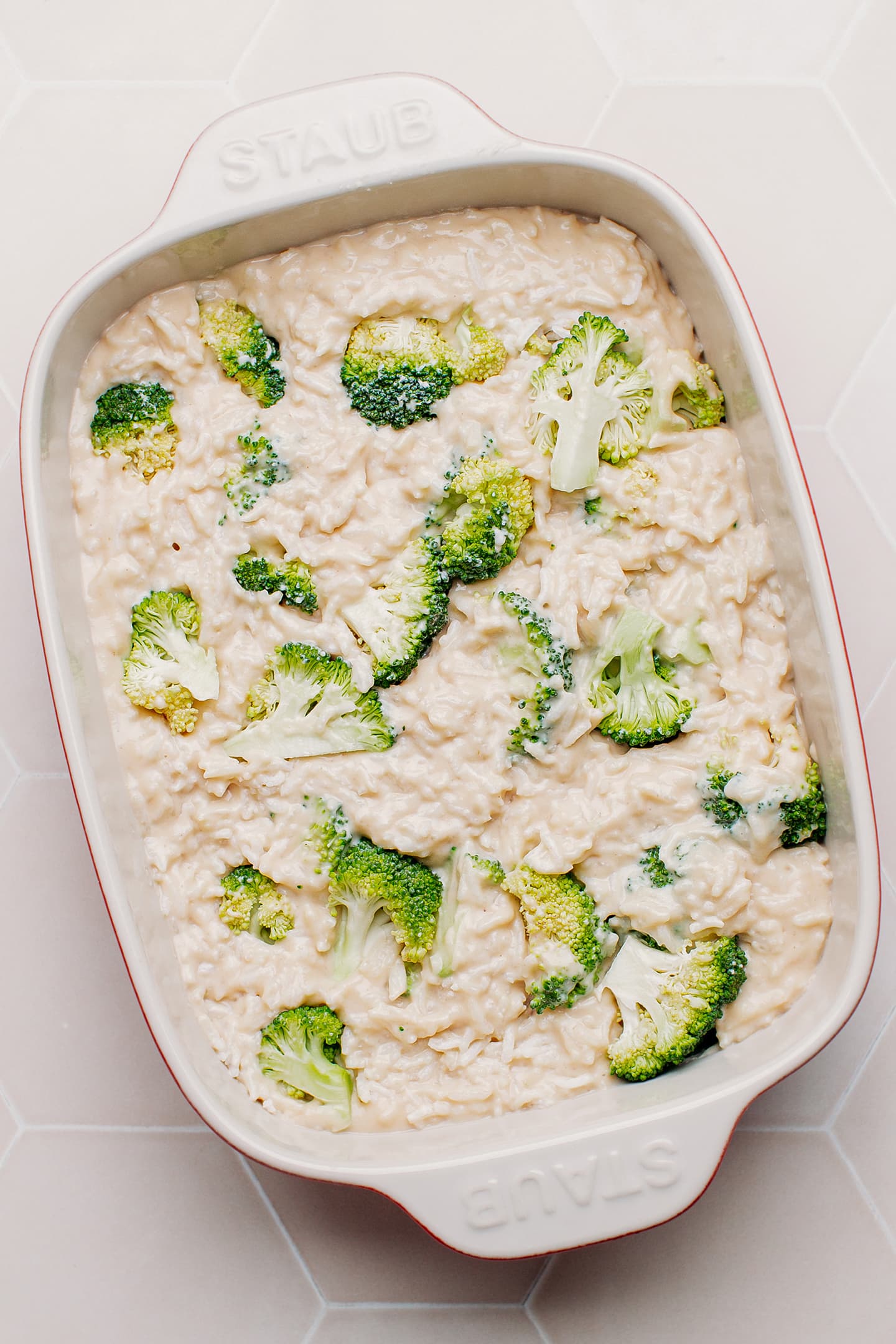
📔 Tips
- Use fresh broccoli. For optimal flavor, I highly recommend using fresh broccoli. Fresh broccoli has a vibrant green color and a firm texture. Avoid using broccoli that is starting to turn yellow or shows signs of mold.
- Strain the cheese sauce. You can strain the sauce through a fine-sieve mesh if you don’t own a powerful blender.
- Cover with foil during baking. Do not forget to cover the casserole with foil during baking. This will prevent the rice and broccoli from browning too quickly.
🧀 Variations
- Swap the broccoli for cauliflower: No broccoli on hand? No problem. You can easily replace the broccoli with cauliflower florets.
- Substitute the rice. Use your favorite cooked grain in place of the rice. Quinoa, millet, bulgur, or even rice cauliflower will work great.
- Add other vegetables: You can add green peas, finely chopped carrots, or even diced mushrooms to this casserole.
- Add the protein of your choice: Want to make this casserole richer in protein? Add shredded vegan chicken, seitan, or vegan sausages.
- Top with grated vegan cheese: If you want even more cheesiness, feel free to top your casserole with grated vegan cheese before baking!
- Top with panko breadcrumbs: Sprinkle the casserole with panko breadcrumbs for a crispy top!
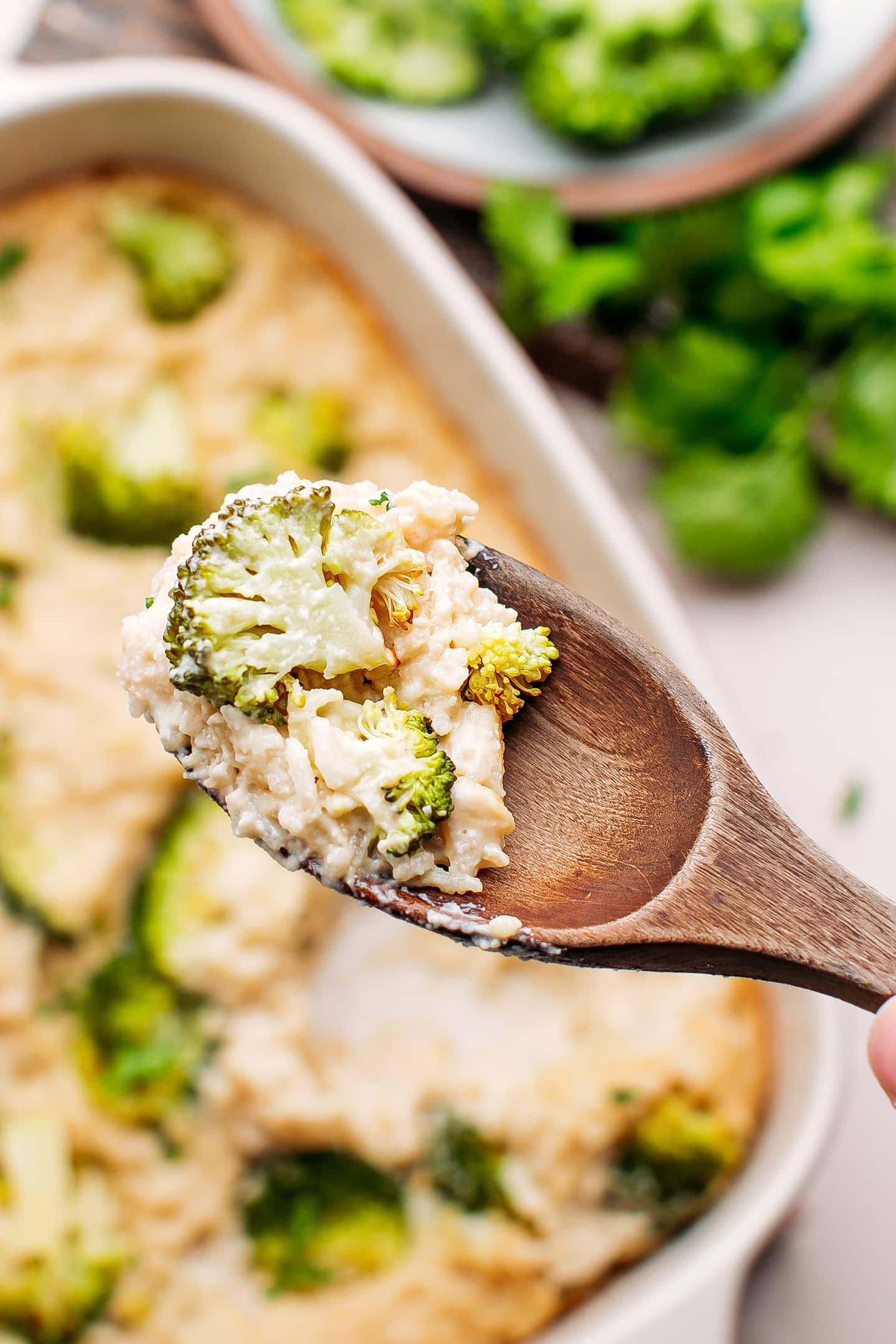
🥗 What to Serve It With
Consider serving this broccoli rice casserole with a green salad like this kale & carrot salad, with cooked vegetables like glazed carrots, or with vegan burger patties!
❄️ Storing and Reheating
- To store: You can store this broccoli rice casserole in the fridge for up to 4 days.
- To freeze: Freeze this casserole whole or in portions for up to 3 months. Thaw overnight in the refrigerator before reheating.
- To reheat: Cover with foil and reheat in a 350°F (175°C) preheated oven for 15-20 minutes.
💬 FAQ
Any type of cooked rice works. Brown rice, long grain, and short grain are all great options.
Yes. You can prepare the filling, cover it with plastic wrap or foil, and store it in the fridge for up to 1 day before baking.
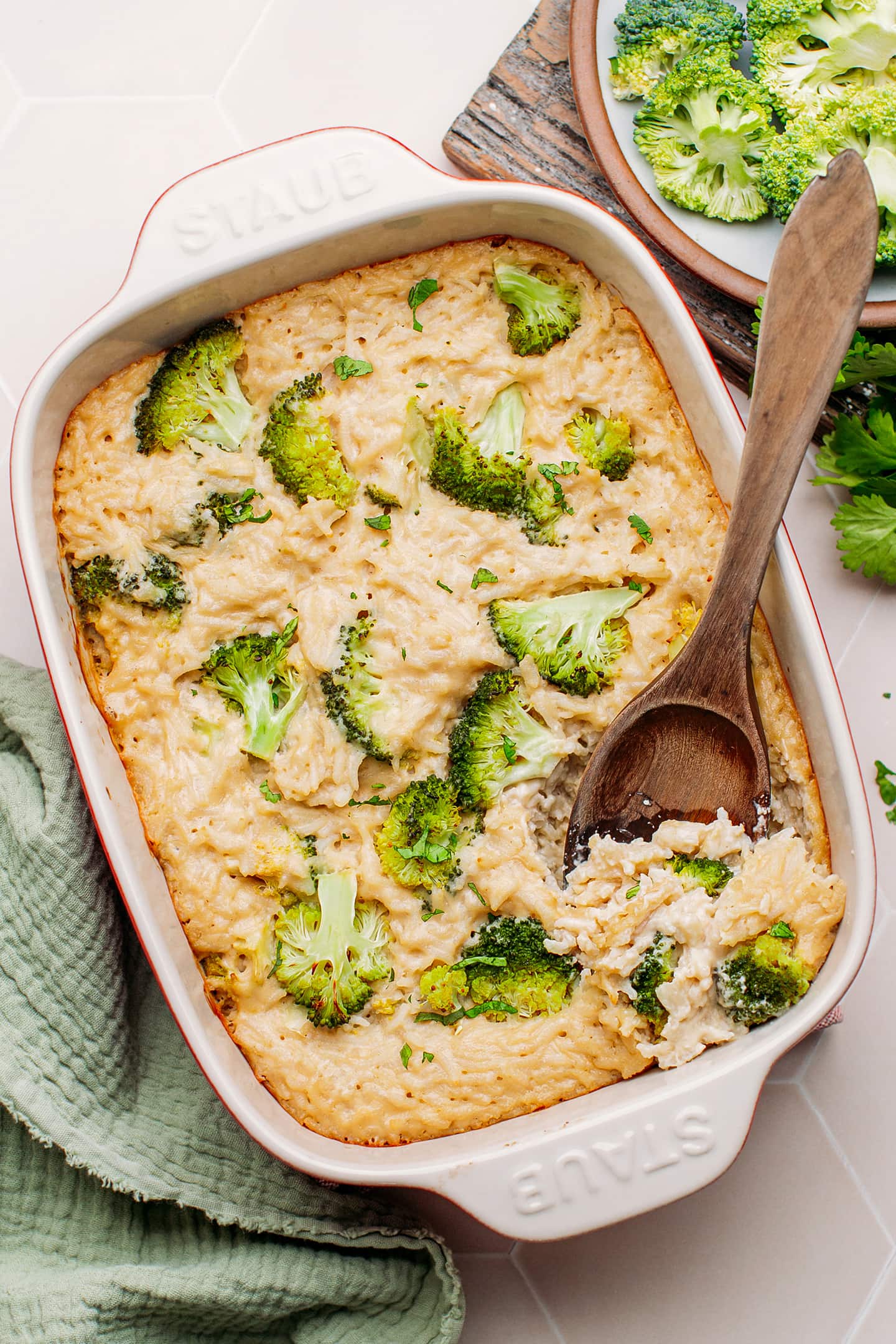
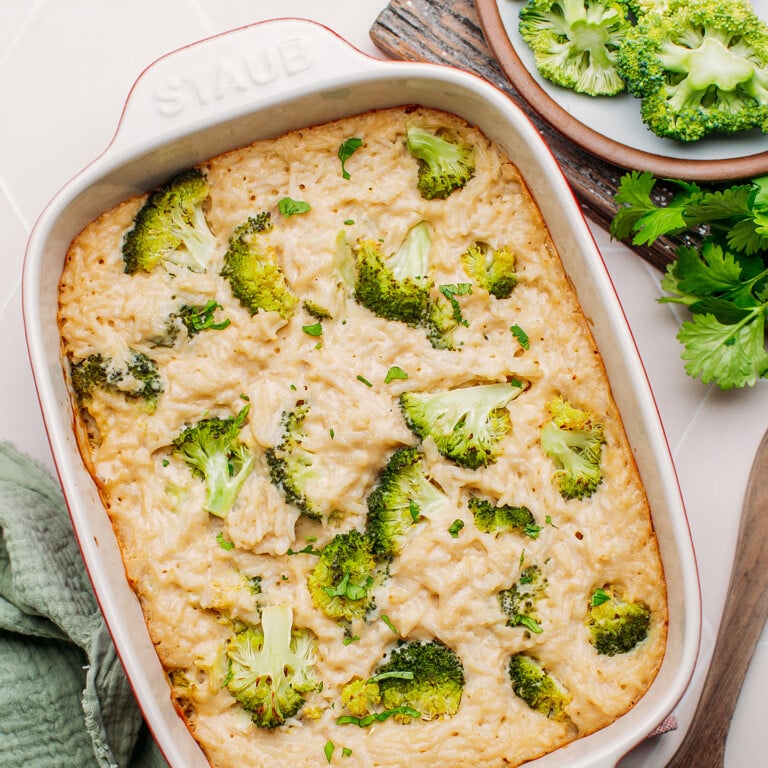
Vegan Broccoli Rice Casserole
Ingredients
Cheese sauce
- 1 cup raw cashews soaked overnight
- 1 and 1/3 cup water
- 1/2 cup white wine
- 1/4 cup nutritional yeast
- 2 tbsp oil
- 1 tbsp white miso
- 1 tbsp sugar
- 2 tsp onion powder
- 1 tsp salt
- 1 clove of garlic
- 2 tbsp tapioca starch
The rest
- 2 cups cooked rice
- 2 cups broccoli florets
Instructions
Cheese sauce
- Soak the cashews. Start by soaking the cashews overnight in cold water. You can speed up the process by pouring boiling water over the cashews and letting them sit for 25-30 minutes.Drain them. Next, rinse the cashews and drain them well.
- Transfer the cashews to a blender. Transfer the soaked cashews to a high-speed blender. Note: you must use a blender for this recipe. A food processor would yield a very chunky texture.
- Add the remaining ingredients. To the blender, add the water, white wine, nutritional yeast, oil, white miso, sugar, onion powder, salt, and garlic.
- Blend until smooth. Blend on high speed for 40-60 seconds or until the sauce is completely smooth.
- Thicken the sauce. Transfer the sauce to a medium saucepan and add the tapioca starch. Heat it over medium heat, whisking constantly until the sauce thickens. This step will take approximately 5 minutes. Set aside.
Casserole
- Coat the rice with the sauce. Transfer the cooked rice and cheese sauce to a mixing bowl. Using a wooden spoon, stir to coat the rice with the sauce. Add the broccoli florets and stir to combine.
- Transfer to a baking dish. Transfer the rice and broccoli with the sauce to a 9×7-inch (23x18cm) oven-safe baking dish.
- Cover with foil. This will prevent the top from browning too quickly and help the casserole to stay creamy.
- Bake until golden brown. Finally, bake the casserole for 35 minutes in a 350°F (175°C) preheated oven. Remove the foil and bake for another 8-10 minutes or until the top is slightly golden brown.
Notes
- Use fresh broccoli. For optimal flavor, I highly recommend using fresh broccoli. Fresh broccoli has a vibrant green color and a firm texture. Avoid using broccoli that is starting to turn yellow or shows signs of mold.
- Strain the cheese sauce. You can strain the sauce through a fine-sieve mesh if you don’t own a powerful blender.
- Cover with foil during baking. Do not forget to cover the casserole with foil during baking. This will prevent the rice and broccoli from browning too quickly.
Nutrition

About the Author
Thomas Pagot is the founder, photographer, and recipe developer behind Full of Plants. He created the blog in 2016 as a personal cookbook for vegan recipes. Through years of recipe development, Thomas has successfully grown Full of Plants into a trusted resource for plant-based recipes.
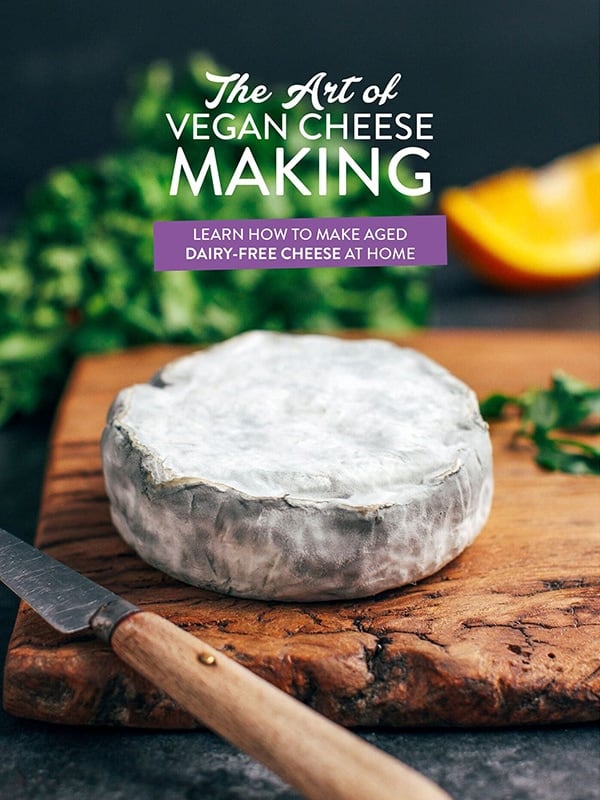
🧀 25 Mind-Blowing Vegan Cheese Recipes!
Sign up for the Full of Plants newsletter and you’ll get new recipes delivered by email weekly, PLUS your FREE 100-page printable eBook!

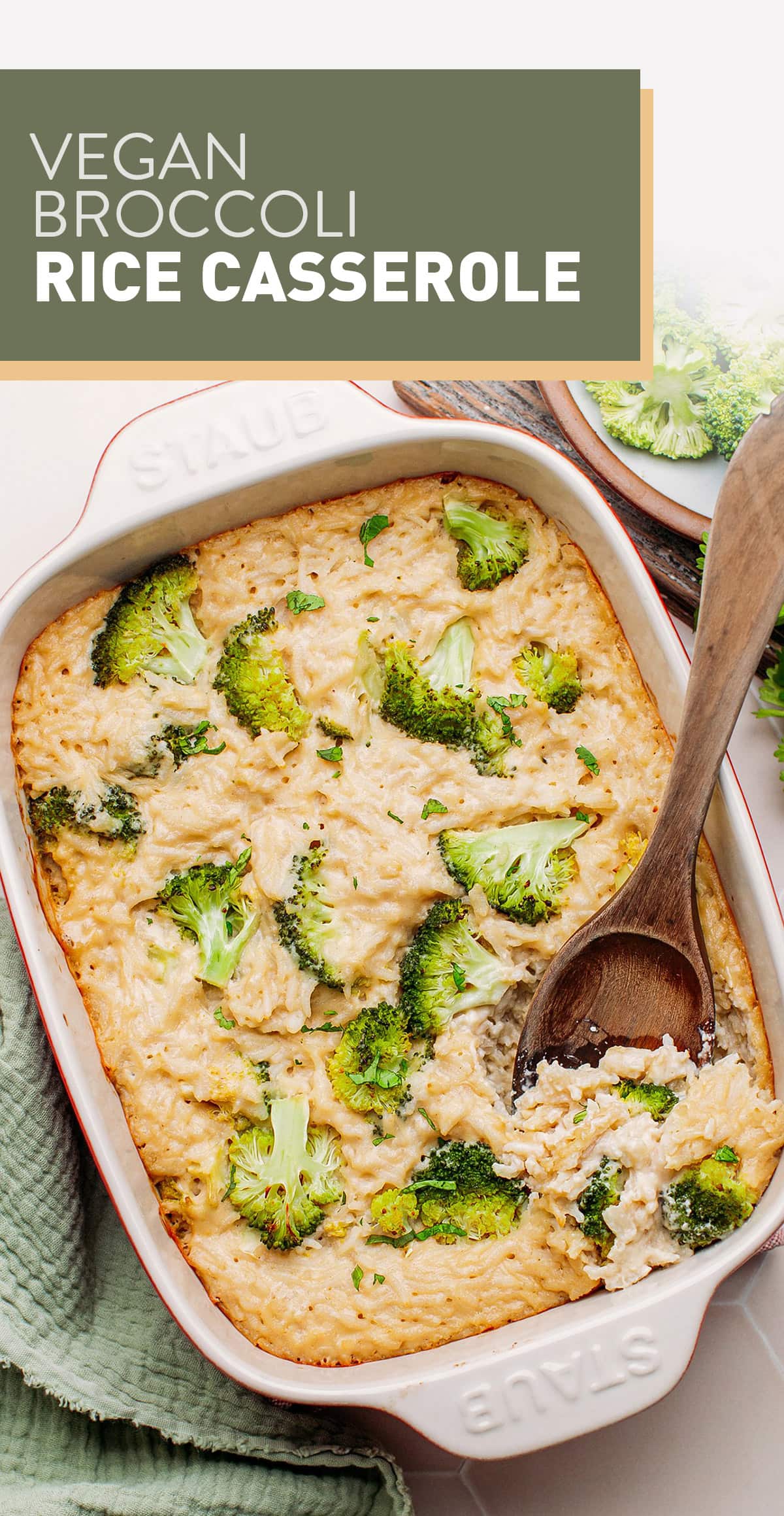
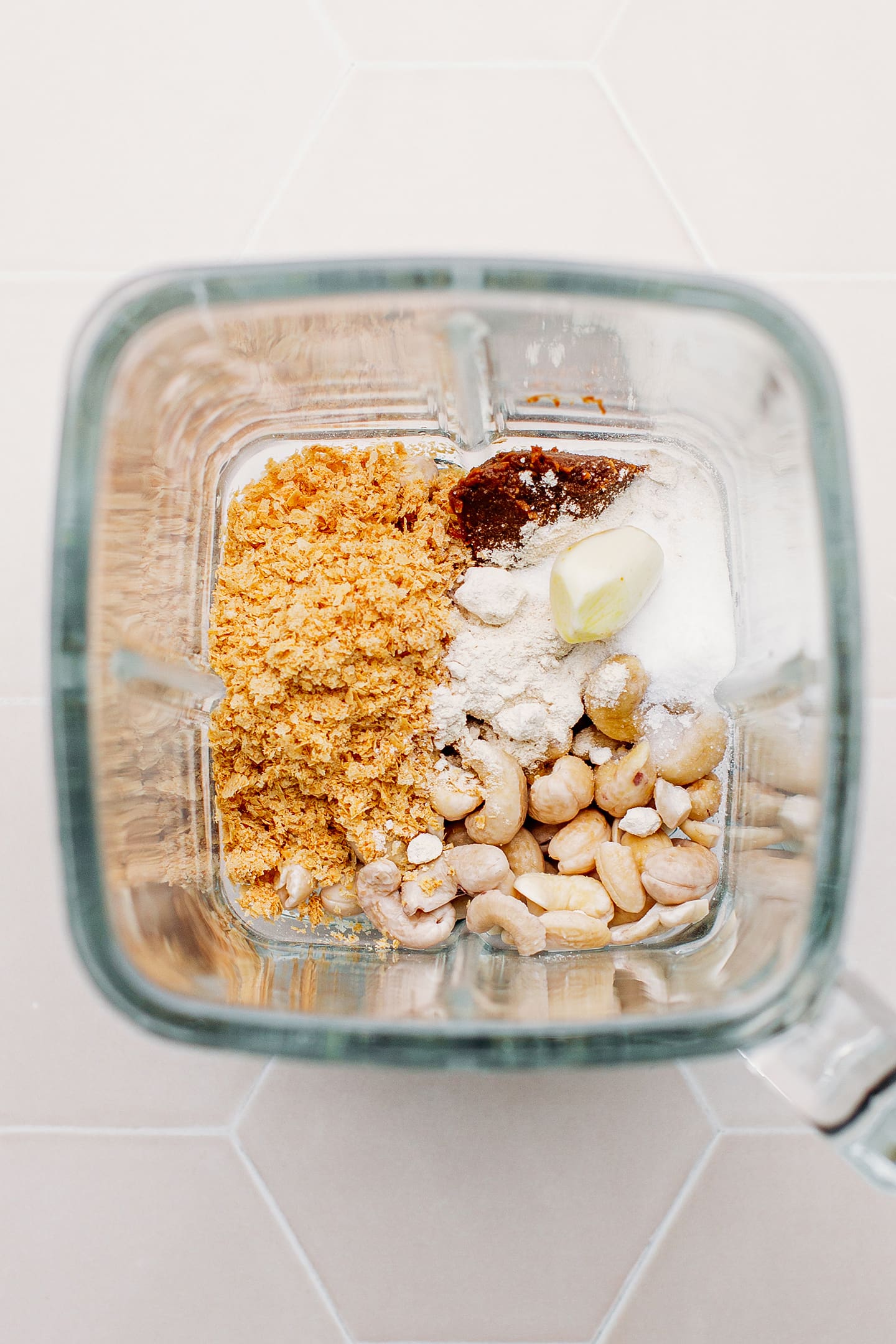
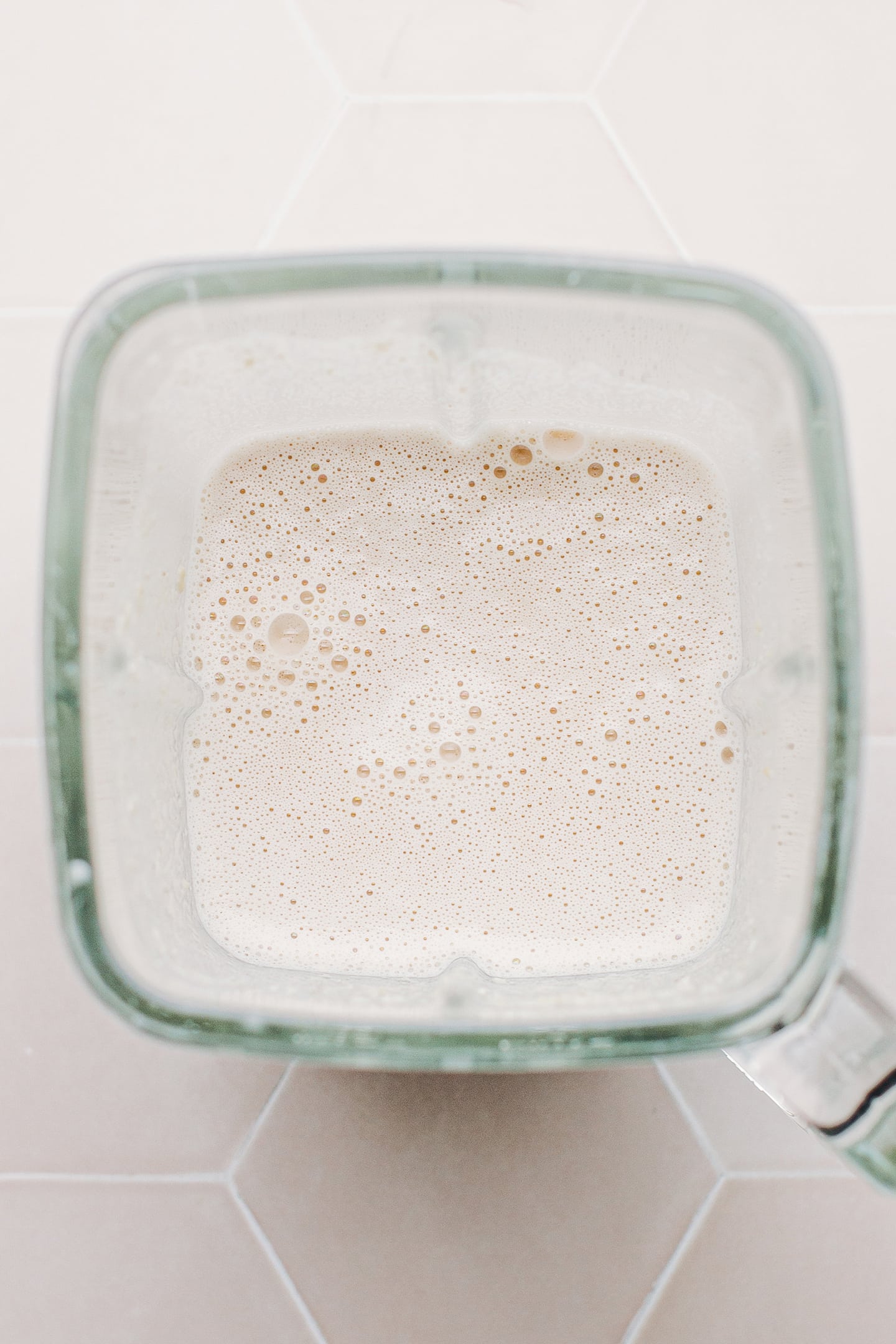
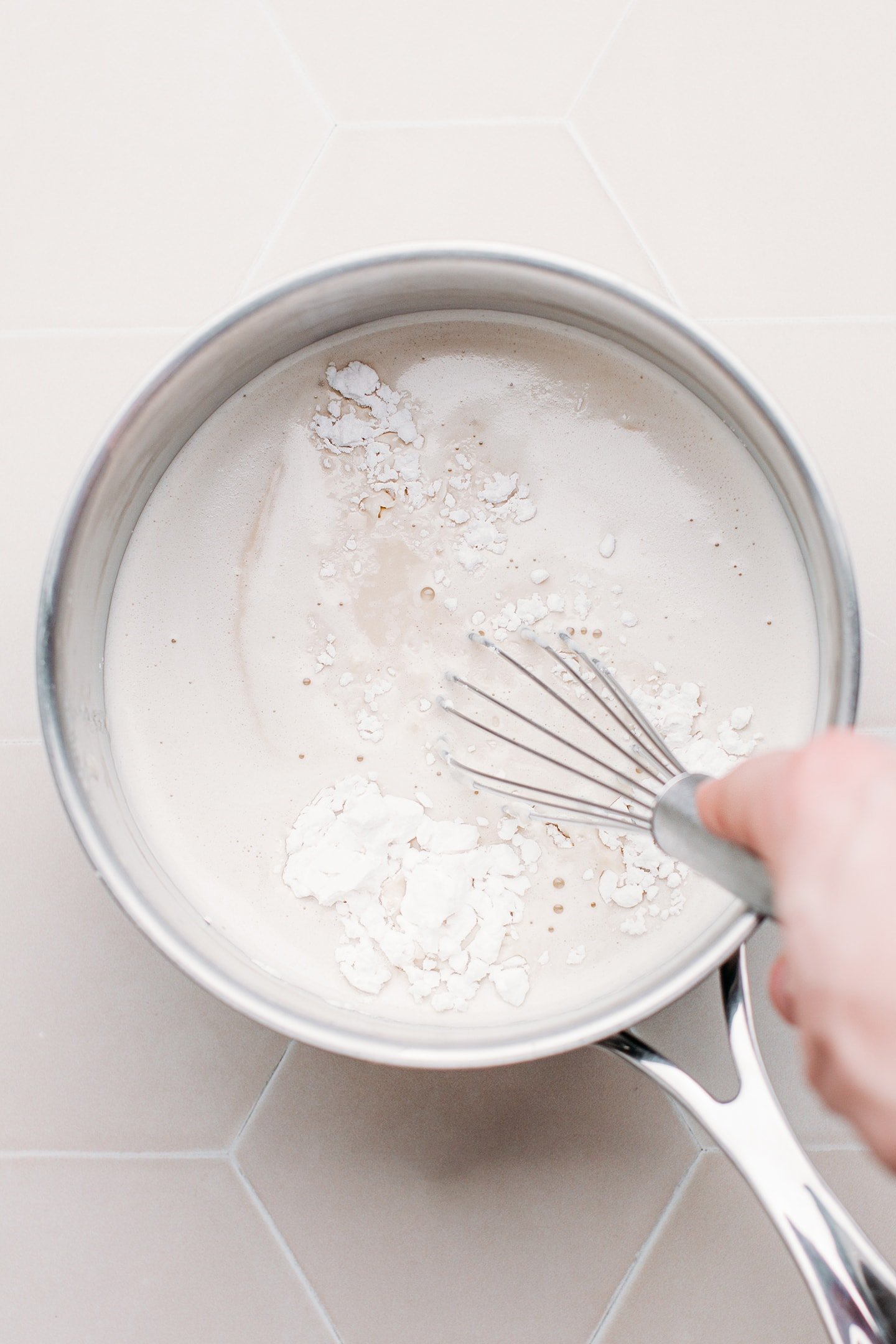
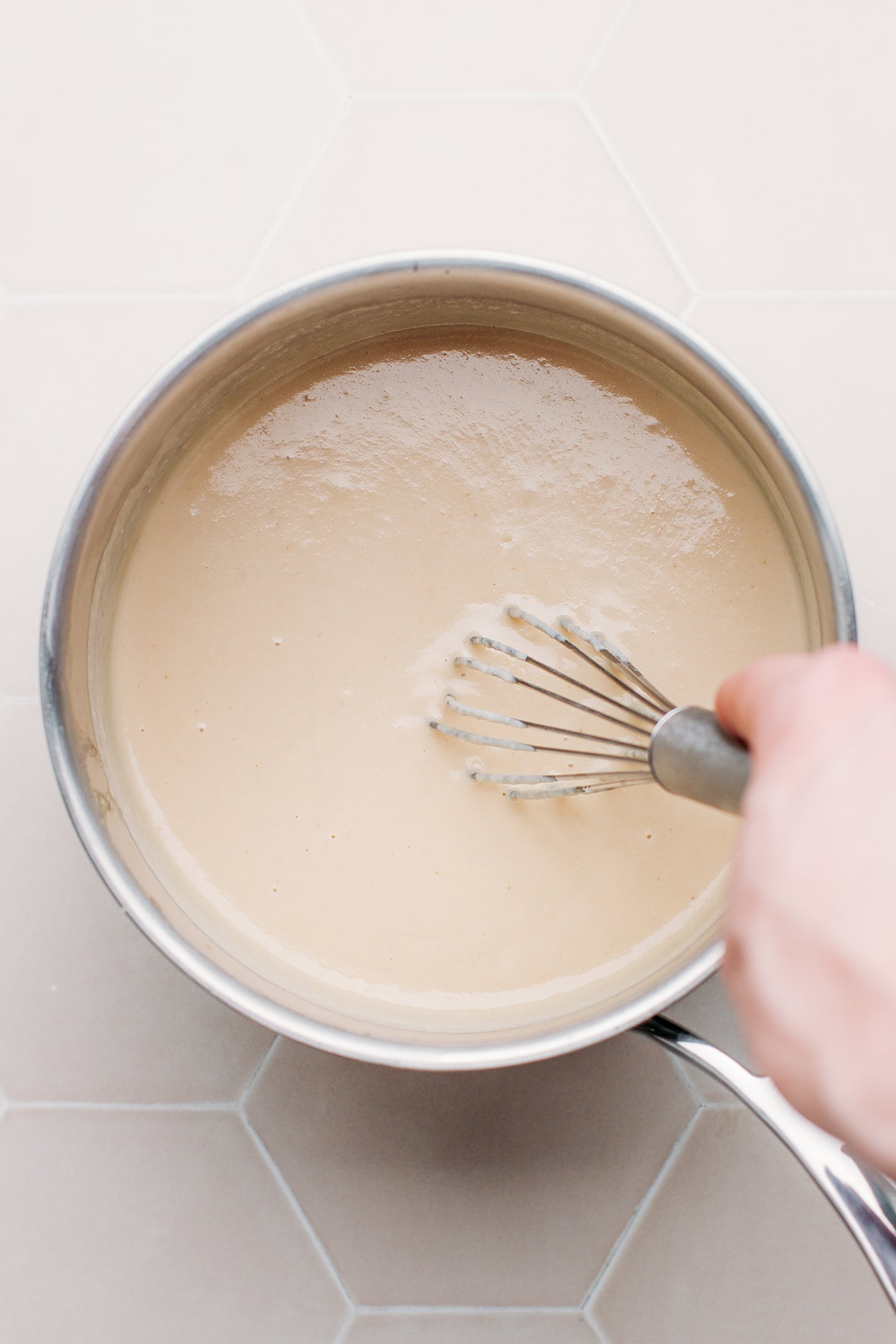
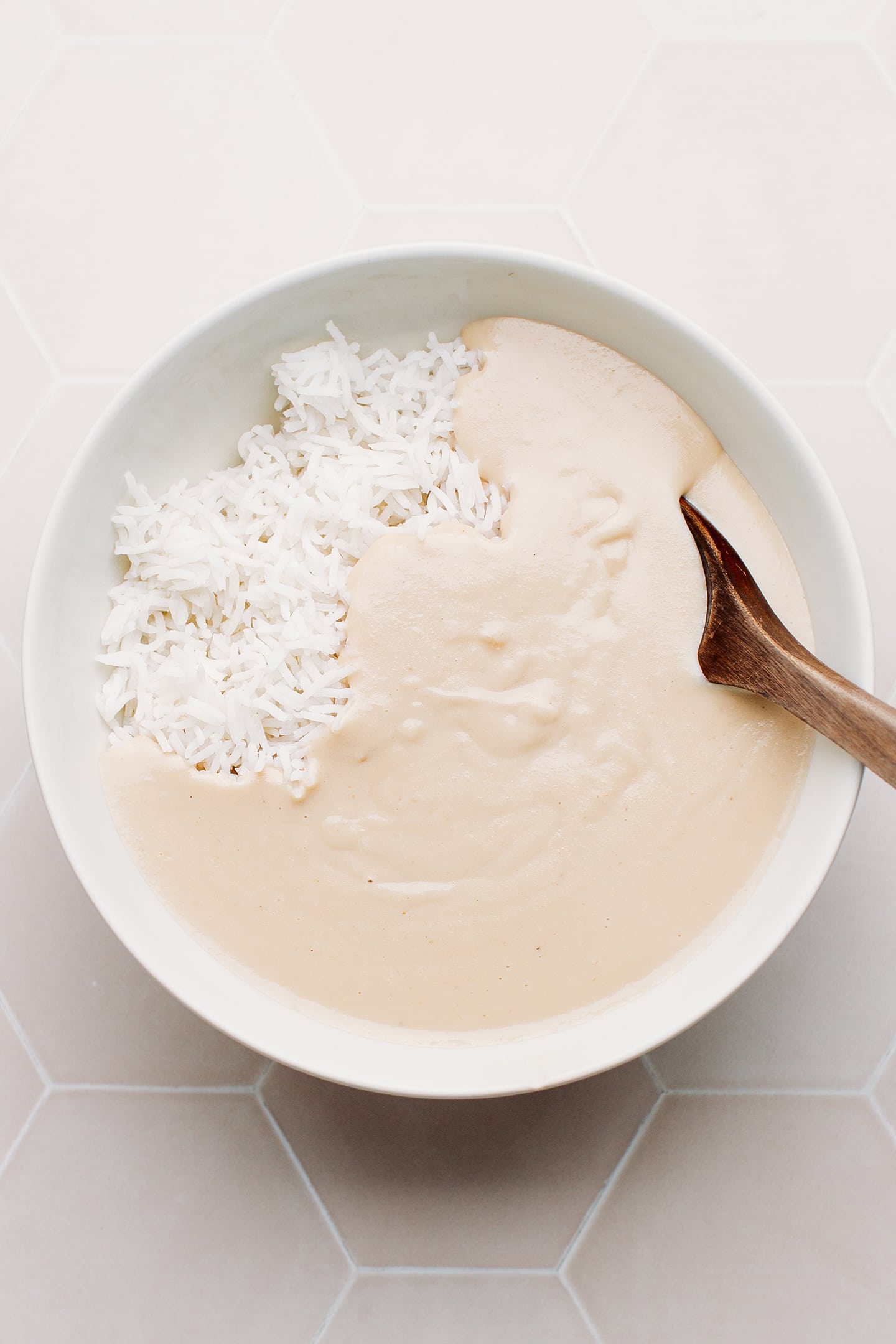
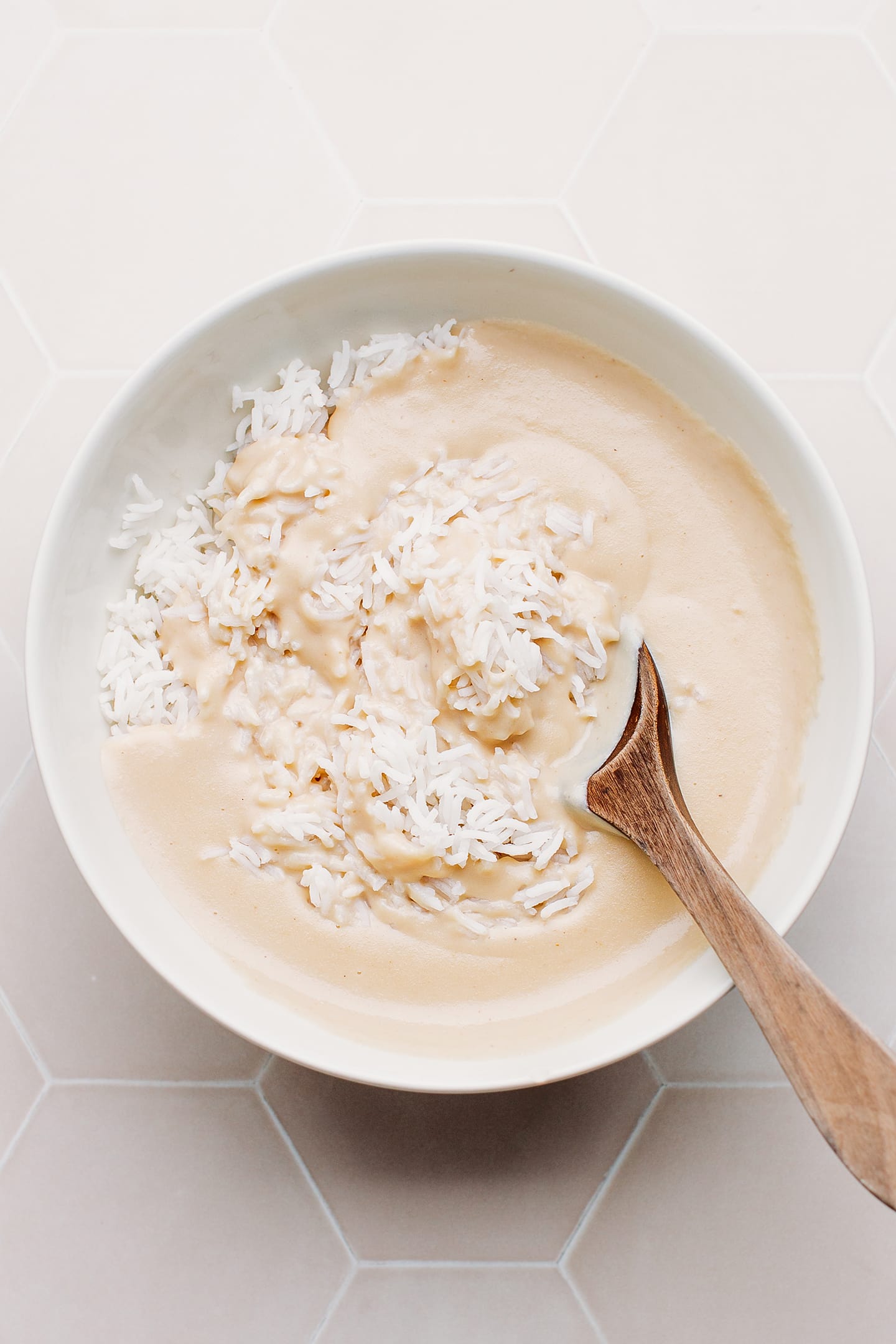
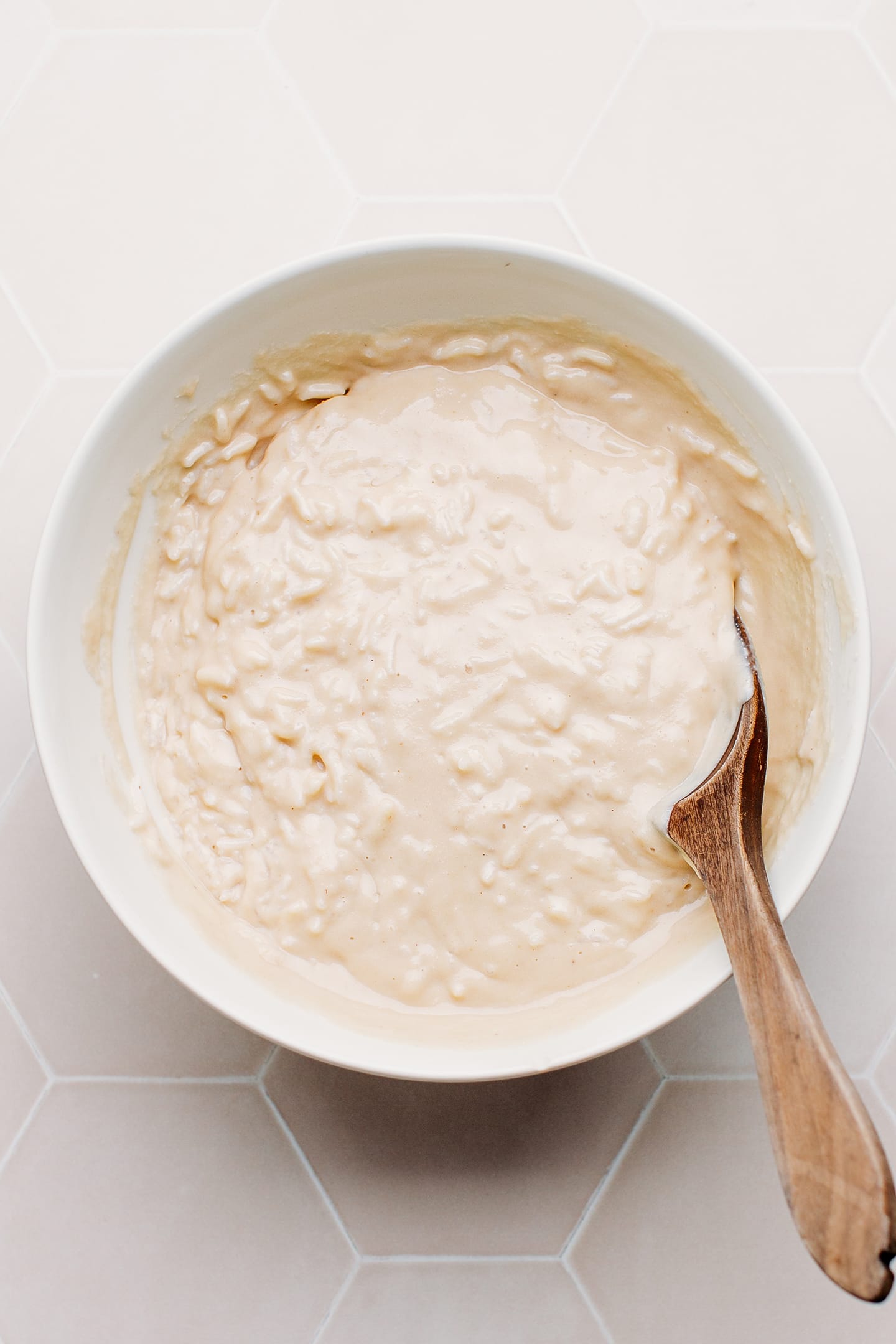
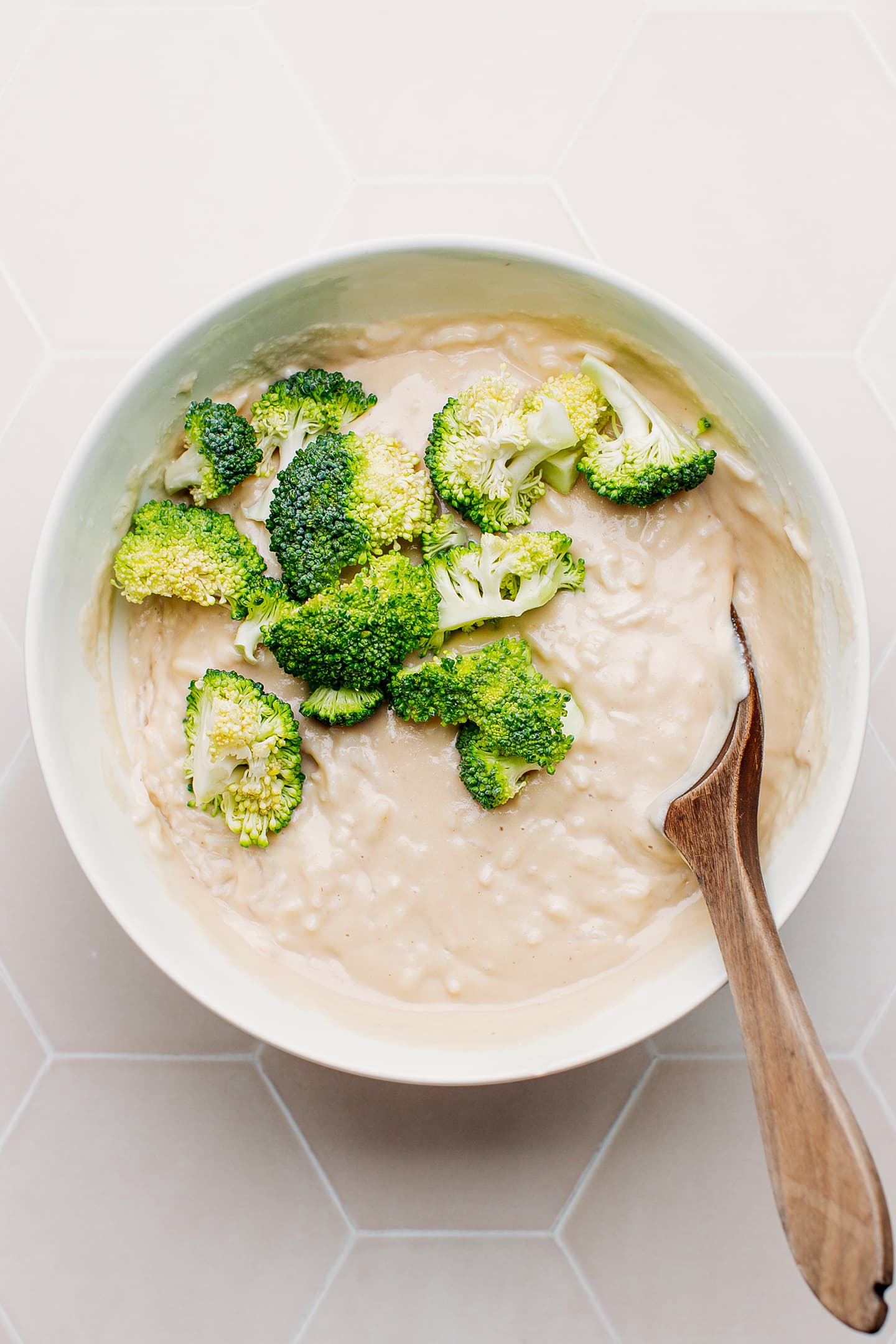
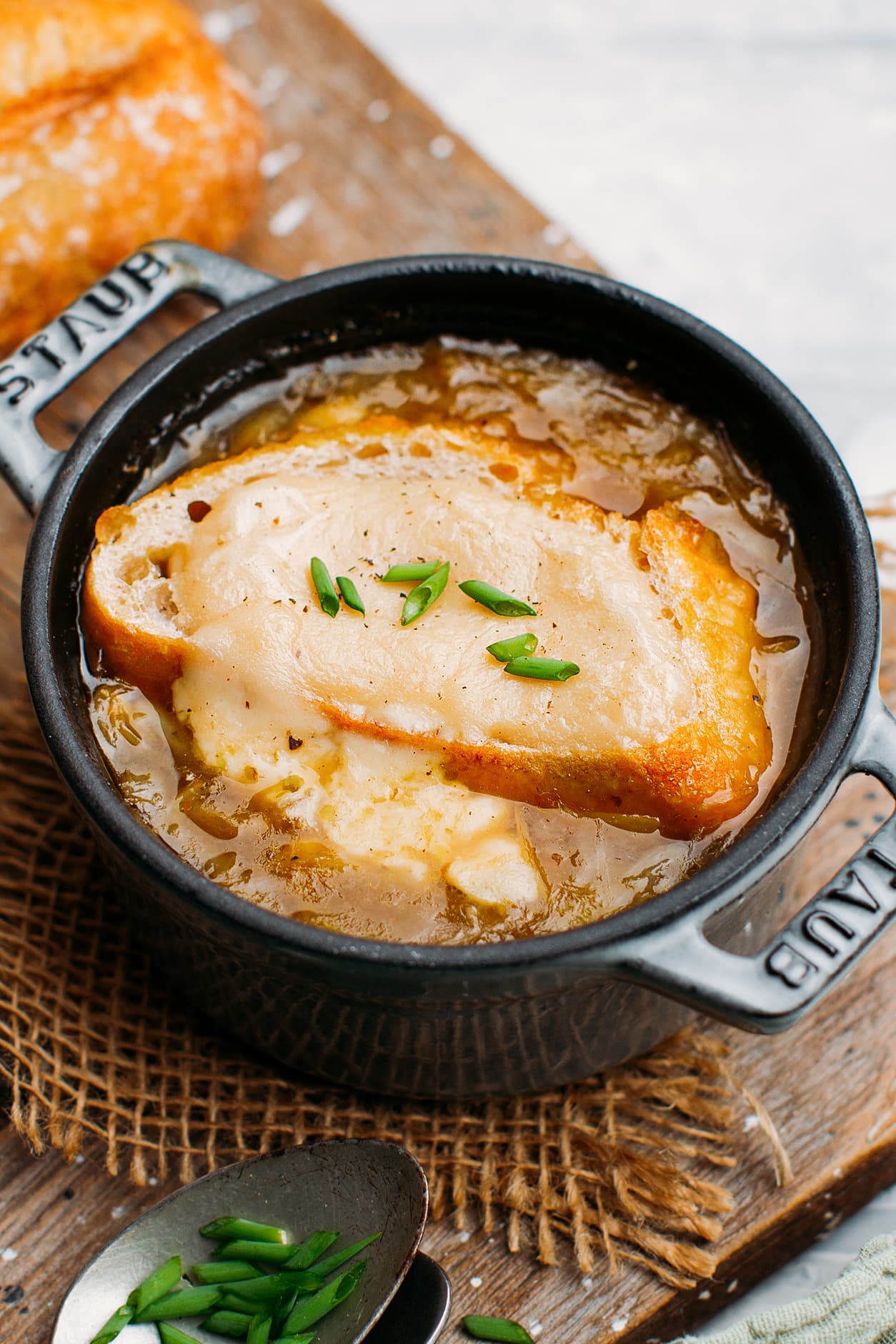
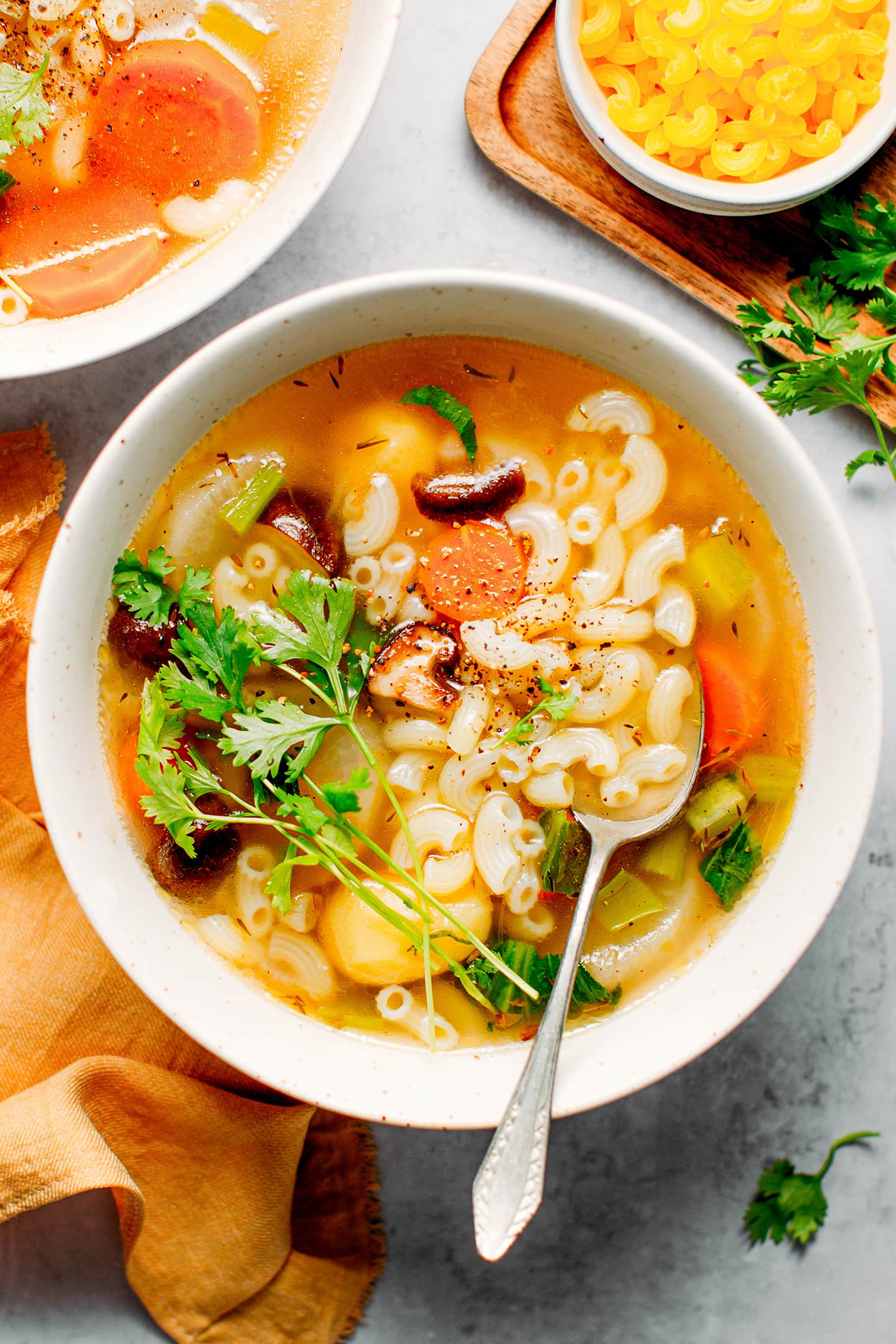
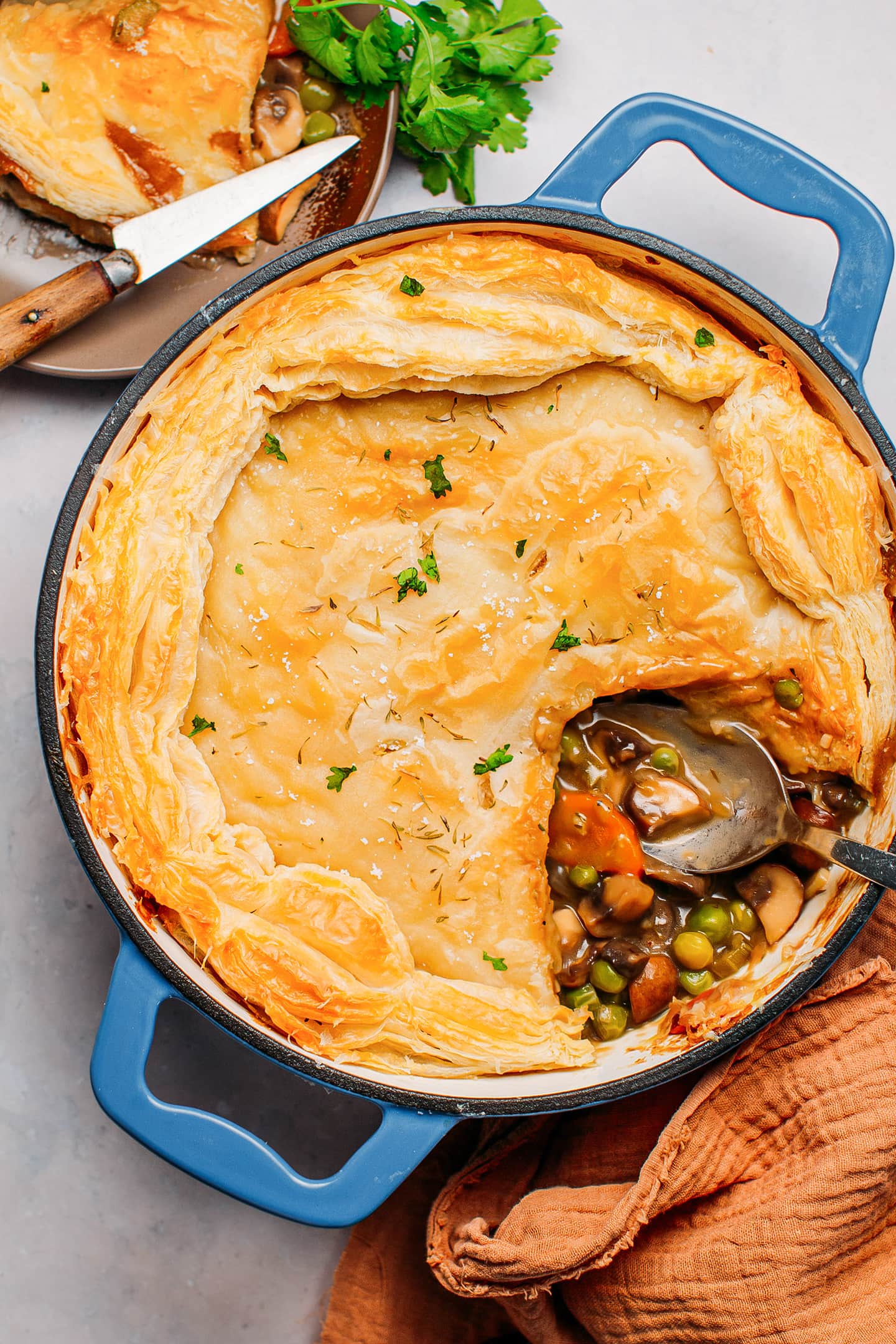
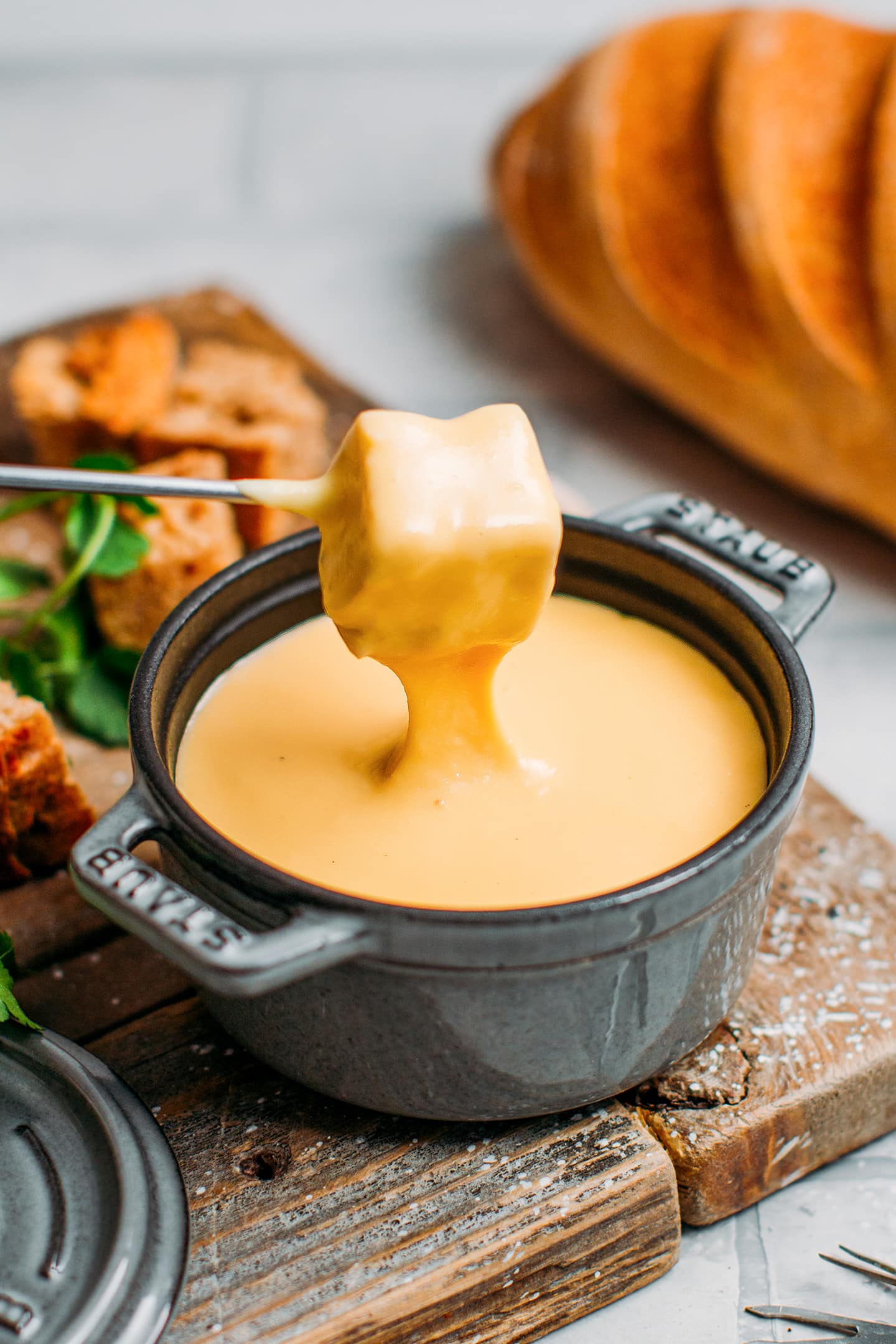
Looks appetissant. I’ll try it this weekend. Thank you.
Hope you will like it Tommy!
Yum. This looks delicious and healthy. The white wine is an interesting addition to the cheeze sauce.
Thanks Thérèse, hope you will like it!